Leadership and Change Management: Analysis in the Healthcare Sector
VerifiedAdded on 2023/06/10
|14
|4045
|438
Report
AI Summary
This report examines leadership and change management within the healthcare sector, with a specific focus on the nursing sector. It discusses the importance of leadership in guiding organizations through change, particularly in response to technological advancements, economic shifts, and environmental regulations. The report analyzes various leadership theories, including transformative and participative leadership, and applies Lewin's change management model to illustrate the change process. It explores the need for change, the role of leaders in identifying and managing change, and the importance of stakeholder involvement and conflict management. The report also highlights the significance of organizational culture in facilitating successful change implementation, emphasizing the need for employee-centric approaches and effective communication. The analysis covers topics like performance improvement strategies, conflict management, and the role of departmental heads in leading change initiatives. The report provides insights into the challenges and opportunities associated with change management in healthcare, offering a comprehensive overview of the key concepts and strategies involved.
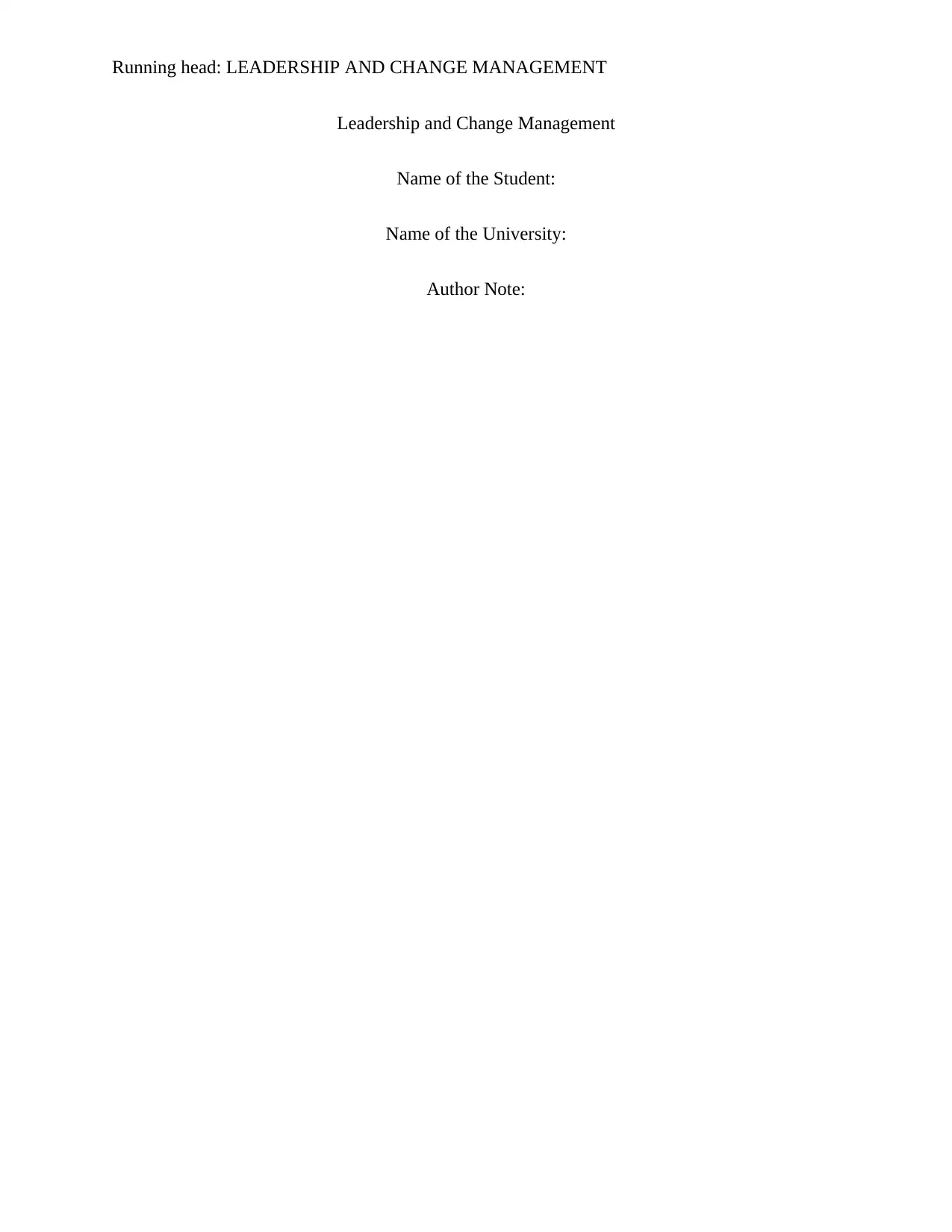
Running head: LEADERSHIP AND CHANGE MANAGEMENT
Leadership and Change Management
Name of the Student:
Name of the University:
Author Note:
Leadership and Change Management
Name of the Student:
Name of the University:
Author Note:
Paraphrase This Document
Need a fresh take? Get an instant paraphrase of this document with our AI Paraphraser
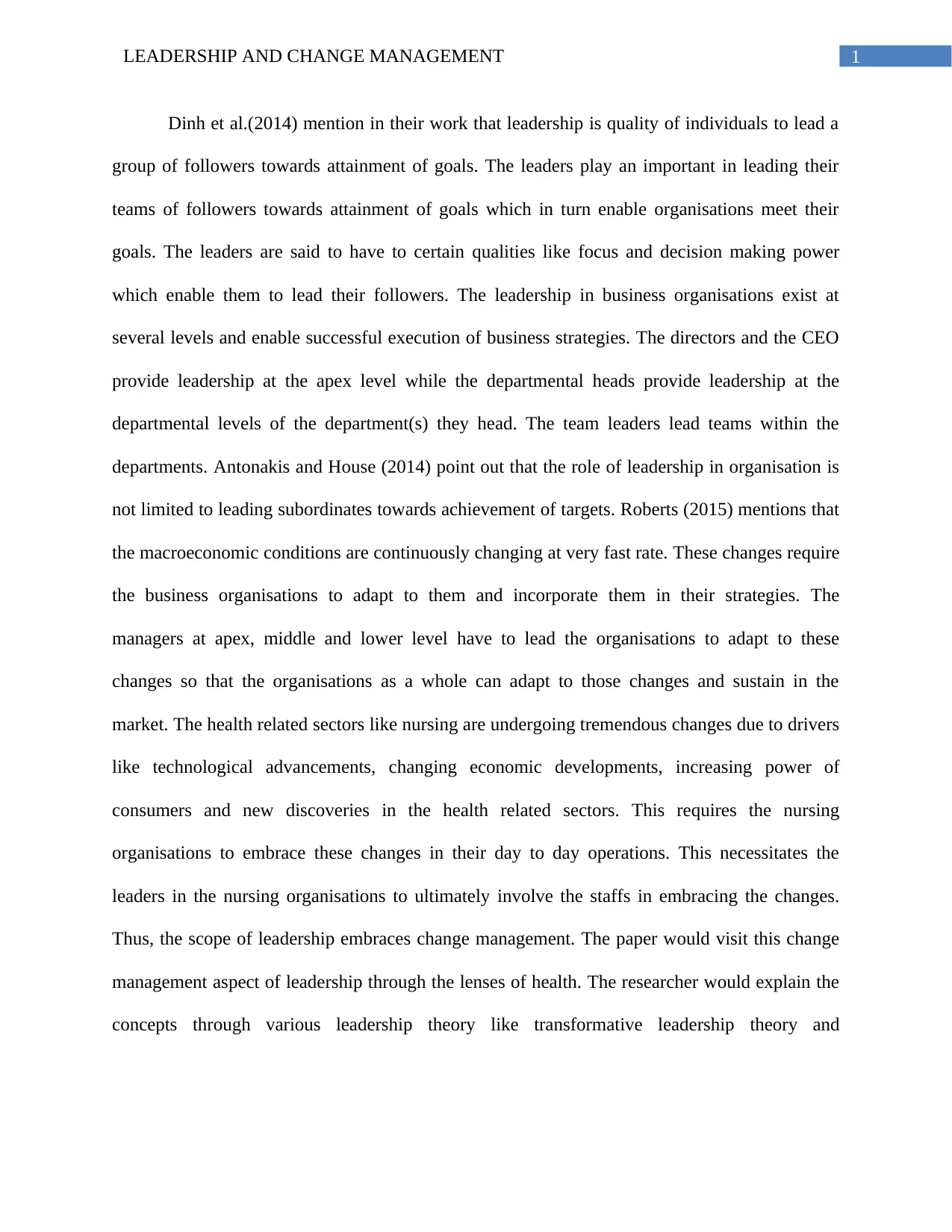
1LEADERSHIP AND CHANGE MANAGEMENT
Dinh et al.(2014) mention in their work that leadership is quality of individuals to lead a
group of followers towards attainment of goals. The leaders play an important in leading their
teams of followers towards attainment of goals which in turn enable organisations meet their
goals. The leaders are said to have to certain qualities like focus and decision making power
which enable them to lead their followers. The leadership in business organisations exist at
several levels and enable successful execution of business strategies. The directors and the CEO
provide leadership at the apex level while the departmental heads provide leadership at the
departmental levels of the department(s) they head. The team leaders lead teams within the
departments. Antonakis and House (2014) point out that the role of leadership in organisation is
not limited to leading subordinates towards achievement of targets. Roberts (2015) mentions that
the macroeconomic conditions are continuously changing at very fast rate. These changes require
the business organisations to adapt to them and incorporate them in their strategies. The
managers at apex, middle and lower level have to lead the organisations to adapt to these
changes so that the organisations as a whole can adapt to those changes and sustain in the
market. The health related sectors like nursing are undergoing tremendous changes due to drivers
like technological advancements, changing economic developments, increasing power of
consumers and new discoveries in the health related sectors. This requires the nursing
organisations to embrace these changes in their day to day operations. This necessitates the
leaders in the nursing organisations to ultimately involve the staffs in embracing the changes.
Thus, the scope of leadership embraces change management. The paper would visit this change
management aspect of leadership through the lenses of health. The researcher would explain the
concepts through various leadership theory like transformative leadership theory and
Dinh et al.(2014) mention in their work that leadership is quality of individuals to lead a
group of followers towards attainment of goals. The leaders play an important in leading their
teams of followers towards attainment of goals which in turn enable organisations meet their
goals. The leaders are said to have to certain qualities like focus and decision making power
which enable them to lead their followers. The leadership in business organisations exist at
several levels and enable successful execution of business strategies. The directors and the CEO
provide leadership at the apex level while the departmental heads provide leadership at the
departmental levels of the department(s) they head. The team leaders lead teams within the
departments. Antonakis and House (2014) point out that the role of leadership in organisation is
not limited to leading subordinates towards achievement of targets. Roberts (2015) mentions that
the macroeconomic conditions are continuously changing at very fast rate. These changes require
the business organisations to adapt to them and incorporate them in their strategies. The
managers at apex, middle and lower level have to lead the organisations to adapt to these
changes so that the organisations as a whole can adapt to those changes and sustain in the
market. The health related sectors like nursing are undergoing tremendous changes due to drivers
like technological advancements, changing economic developments, increasing power of
consumers and new discoveries in the health related sectors. This requires the nursing
organisations to embrace these changes in their day to day operations. This necessitates the
leaders in the nursing organisations to ultimately involve the staffs in embracing the changes.
Thus, the scope of leadership embraces change management. The paper would visit this change
management aspect of leadership through the lenses of health. The researcher would explain the
concepts through various leadership theory like transformative leadership theory and

2LEADERSHIP AND CHANGE MANAGEMENT
participative leadership style. As far as change management model is concerned, the researcher
would Lewin’s change management model.
The leaders according to Cameron and Green (2015) in the present era have to play the
significant role of leading the staff towards embracing the changes and management the change
processes within the organisation. The changes in the external economic scenario today are far
more dynamic than in any single business organisation or even an industry can regulate or resist.
The nursing is one such sector which is experiencing drastic changes in the current period. The
technological advancements in the medical science and pharmaceutical have required the
management of the firms operating in the sector to install these new technological processes in
their manufacturing process. The countries like the United States which house several leading
nursing organisations are automatically forced to enact laws to protect the intellectual properties
of the nursing firms continuously bringing about these advancements and discoveries. For
example, the health sector in the country is helmed by US Food and Drug Administration
(fda.gov, 2018). The firms irrespective of their countries of domicile have to comply with these
norms and laws enacted in their host countries as well. Another factor which is driving changes
in the health sector is environmental aspect. The governments of different countries are enforcing
steps to curb environmental damages are enacting various laws. For example, the nursing
organisations operating in Australia irrespective of industries have to comply with the
Environment Protection and Biodiversity Conservation Act 1999 (environment.gov.au, 2018).
These laws apply to health sector due to various reasons. First, the health sector provides goods
like medicines and medical equipment and services like pathological tests, all of which are basic
necessities of life. These products have direct impact on the health and welfare of the end
consumers not only on short term and long term. The health sector companies acquire immense
participative leadership style. As far as change management model is concerned, the researcher
would Lewin’s change management model.
The leaders according to Cameron and Green (2015) in the present era have to play the
significant role of leading the staff towards embracing the changes and management the change
processes within the organisation. The changes in the external economic scenario today are far
more dynamic than in any single business organisation or even an industry can regulate or resist.
The nursing is one such sector which is experiencing drastic changes in the current period. The
technological advancements in the medical science and pharmaceutical have required the
management of the firms operating in the sector to install these new technological processes in
their manufacturing process. The countries like the United States which house several leading
nursing organisations are automatically forced to enact laws to protect the intellectual properties
of the nursing firms continuously bringing about these advancements and discoveries. For
example, the health sector in the country is helmed by US Food and Drug Administration
(fda.gov, 2018). The firms irrespective of their countries of domicile have to comply with these
norms and laws enacted in their host countries as well. Another factor which is driving changes
in the health sector is environmental aspect. The governments of different countries are enforcing
steps to curb environmental damages are enacting various laws. For example, the nursing
organisations operating in Australia irrespective of industries have to comply with the
Environment Protection and Biodiversity Conservation Act 1999 (environment.gov.au, 2018).
These laws apply to health sector due to various reasons. First, the health sector provides goods
like medicines and medical equipment and services like pathological tests, all of which are basic
necessities of life. These products have direct impact on the health and welfare of the end
consumers not only on short term and long term. The health sector companies acquire immense
⊘ This is a preview!⊘
Do you want full access?
Subscribe today to unlock all pages.

Trusted by 1+ million students worldwide

3LEADERSHIP AND CHANGE MANAGEMENT
amount of raw materials. For example, the pharmaceutical companies acquire chemicals to make
medicines whereas the pathological equipment manufacturing companies acquire immense
amount of steel and metal pieces. This means these nursing organisations acquire their raw
materials from the environment. Similarly, the health sector companies release immense amount
of wastes as bye-products of their production process. The health sector segments like hospitals
release immense amount of wastes like cotton, glass and medical wastes as a bye-products of
their treatment services. Chudasama et al.(2017) in this regard point out that biomedical wastes
released by health sector organisations like hospitals have fatal effects on the environment. Bio
medical wastes contains immense amount of chemicals which can poison water resources and
soil. They undergo putrefaction and chemical breakdown to release dangerous gases. The
chemicals from these wastes mix with the soil as they breakdown and makes it poisonous. These
wastes harbour and release germs which spread in the society, thus causing havoc to social
health. These critical and far reaching effects of the health sector on the environment have made
the health sector companies come under scanner of environmental laws (Singh, Gupta & Tomar,
2016). There have been cases when leading multinational pharmaceutical companies have been
fined for violating environmental laws. For example, Pfizer was fined $ 190000 by the
Government of Puerto Rico for violating Clean Air Act (statnews.com, 2018). This discussion
clearly shows that the business organisations need to change their modes of operations to adapt
to these changes and macroeconomic consequences which means the employees need to align
their operating ways. It is also clear that the changes cannot be brought about without
management support because they require immense investment. For example, switching over to
more environment friendly requires installation of waste management plants which is extremely
expensive. Thus today management bodies of the nursing firms are not only responsible for
amount of raw materials. For example, the pharmaceutical companies acquire chemicals to make
medicines whereas the pathological equipment manufacturing companies acquire immense
amount of steel and metal pieces. This means these nursing organisations acquire their raw
materials from the environment. Similarly, the health sector companies release immense amount
of wastes as bye-products of their production process. The health sector segments like hospitals
release immense amount of wastes like cotton, glass and medical wastes as a bye-products of
their treatment services. Chudasama et al.(2017) in this regard point out that biomedical wastes
released by health sector organisations like hospitals have fatal effects on the environment. Bio
medical wastes contains immense amount of chemicals which can poison water resources and
soil. They undergo putrefaction and chemical breakdown to release dangerous gases. The
chemicals from these wastes mix with the soil as they breakdown and makes it poisonous. These
wastes harbour and release germs which spread in the society, thus causing havoc to social
health. These critical and far reaching effects of the health sector on the environment have made
the health sector companies come under scanner of environmental laws (Singh, Gupta & Tomar,
2016). There have been cases when leading multinational pharmaceutical companies have been
fined for violating environmental laws. For example, Pfizer was fined $ 190000 by the
Government of Puerto Rico for violating Clean Air Act (statnews.com, 2018). This discussion
clearly shows that the business organisations need to change their modes of operations to adapt
to these changes and macroeconomic consequences which means the employees need to align
their operating ways. It is also clear that the changes cannot be brought about without
management support because they require immense investment. For example, switching over to
more environment friendly requires installation of waste management plants which is extremely
expensive. Thus today management bodies of the nursing firms are not only responsible for
Paraphrase This Document
Need a fresh take? Get an instant paraphrase of this document with our AI Paraphraser
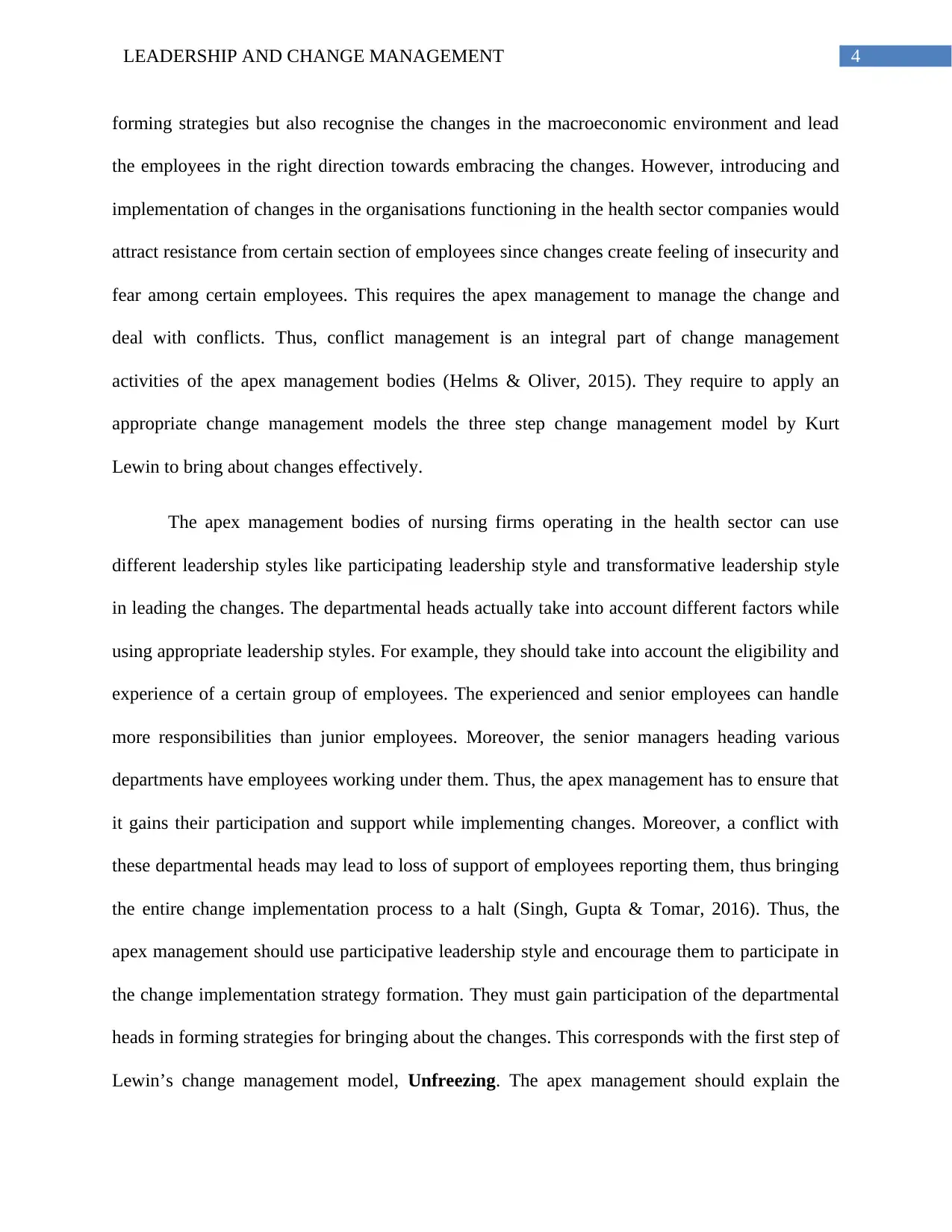
4LEADERSHIP AND CHANGE MANAGEMENT
forming strategies but also recognise the changes in the macroeconomic environment and lead
the employees in the right direction towards embracing the changes. However, introducing and
implementation of changes in the organisations functioning in the health sector companies would
attract resistance from certain section of employees since changes create feeling of insecurity and
fear among certain employees. This requires the apex management to manage the change and
deal with conflicts. Thus, conflict management is an integral part of change management
activities of the apex management bodies (Helms & Oliver, 2015). They require to apply an
appropriate change management models the three step change management model by Kurt
Lewin to bring about changes effectively.
The apex management bodies of nursing firms operating in the health sector can use
different leadership styles like participating leadership style and transformative leadership style
in leading the changes. The departmental heads actually take into account different factors while
using appropriate leadership styles. For example, they should take into account the eligibility and
experience of a certain group of employees. The experienced and senior employees can handle
more responsibilities than junior employees. Moreover, the senior managers heading various
departments have employees working under them. Thus, the apex management has to ensure that
it gains their participation and support while implementing changes. Moreover, a conflict with
these departmental heads may lead to loss of support of employees reporting them, thus bringing
the entire change implementation process to a halt (Singh, Gupta & Tomar, 2016). Thus, the
apex management should use participative leadership style and encourage them to participate in
the change implementation strategy formation. They must gain participation of the departmental
heads in forming strategies for bringing about the changes. This corresponds with the first step of
Lewin’s change management model, Unfreezing. The apex management should explain the
forming strategies but also recognise the changes in the macroeconomic environment and lead
the employees in the right direction towards embracing the changes. However, introducing and
implementation of changes in the organisations functioning in the health sector companies would
attract resistance from certain section of employees since changes create feeling of insecurity and
fear among certain employees. This requires the apex management to manage the change and
deal with conflicts. Thus, conflict management is an integral part of change management
activities of the apex management bodies (Helms & Oliver, 2015). They require to apply an
appropriate change management models the three step change management model by Kurt
Lewin to bring about changes effectively.
The apex management bodies of nursing firms operating in the health sector can use
different leadership styles like participating leadership style and transformative leadership style
in leading the changes. The departmental heads actually take into account different factors while
using appropriate leadership styles. For example, they should take into account the eligibility and
experience of a certain group of employees. The experienced and senior employees can handle
more responsibilities than junior employees. Moreover, the senior managers heading various
departments have employees working under them. Thus, the apex management has to ensure that
it gains their participation and support while implementing changes. Moreover, a conflict with
these departmental heads may lead to loss of support of employees reporting them, thus bringing
the entire change implementation process to a halt (Singh, Gupta & Tomar, 2016). Thus, the
apex management should use participative leadership style and encourage them to participate in
the change implementation strategy formation. They must gain participation of the departmental
heads in forming strategies for bringing about the changes. This corresponds with the first step of
Lewin’s change management model, Unfreezing. The apex management should explain the

5LEADERSHIP AND CHANGE MANAGEMENT
importance of embracing the change. For example, the apex management can point out the
advantages of adopting a modern waste management in order to reduce expenditure due to
environmental penalties. The apex management can also point out to the necessities of adopting
a more employee centric organisational culture and giving decision making power to lower level
employees to a certain extent (Helms & Oliver, 2015). It can be pointed out that all the manager
may not view these changes as positive and some may view them as challenges to their position.
The authoritative managers may consider empowerment of lower level employees as a challenge
to their own power. Again, the departmental heads following transformational leadership may
view this empowerment as an opportunity to gain more support from subordinates, thus reducing
their job pressure to a certain extent. Thus, the first group of managers would conflict with the
apex management while the second group of managers would support the change. Thus, the apex
management in order to gain support of both the groups of managers and ultimately embrace the
changes, must follow participative and transformative leadership style (Chudasama et al. 2017).
The junior employees having less experience should however be led using authoritative
leadership style. The management must also establish system of staff training and counselling to
deal with the fear and insecurities of the departmental heads. The departmental heads in turn
should mentor and coach their subordinates in order to help cope with their fear and insecurities
revolving around the changes. The apex management in order to the change effectively establish
and maintain a smooth communication between itself and the employees. This would effective
use of leadership style combining participative, transformative and authoritative leadership styles
by the apex management would lead to the next level, Change (Singh, Gupta & Tomar, 2016).
The culture of the workplace which the apex management creates using appropriate
leadership style plays a great role in bringing about the next stage of organisational change
importance of embracing the change. For example, the apex management can point out the
advantages of adopting a modern waste management in order to reduce expenditure due to
environmental penalties. The apex management can also point out to the necessities of adopting
a more employee centric organisational culture and giving decision making power to lower level
employees to a certain extent (Helms & Oliver, 2015). It can be pointed out that all the manager
may not view these changes as positive and some may view them as challenges to their position.
The authoritative managers may consider empowerment of lower level employees as a challenge
to their own power. Again, the departmental heads following transformational leadership may
view this empowerment as an opportunity to gain more support from subordinates, thus reducing
their job pressure to a certain extent. Thus, the first group of managers would conflict with the
apex management while the second group of managers would support the change. Thus, the apex
management in order to gain support of both the groups of managers and ultimately embrace the
changes, must follow participative and transformative leadership style (Chudasama et al. 2017).
The junior employees having less experience should however be led using authoritative
leadership style. The management must also establish system of staff training and counselling to
deal with the fear and insecurities of the departmental heads. The departmental heads in turn
should mentor and coach their subordinates in order to help cope with their fear and insecurities
revolving around the changes. The apex management in order to the change effectively establish
and maintain a smooth communication between itself and the employees. This would effective
use of leadership style combining participative, transformative and authoritative leadership styles
by the apex management would lead to the next level, Change (Singh, Gupta & Tomar, 2016).
The culture of the workplace which the apex management creates using appropriate
leadership style plays a great role in bringing about the next stage of organisational change
⊘ This is a preview!⊘
Do you want full access?
Subscribe today to unlock all pages.

Trusted by 1+ million students worldwide
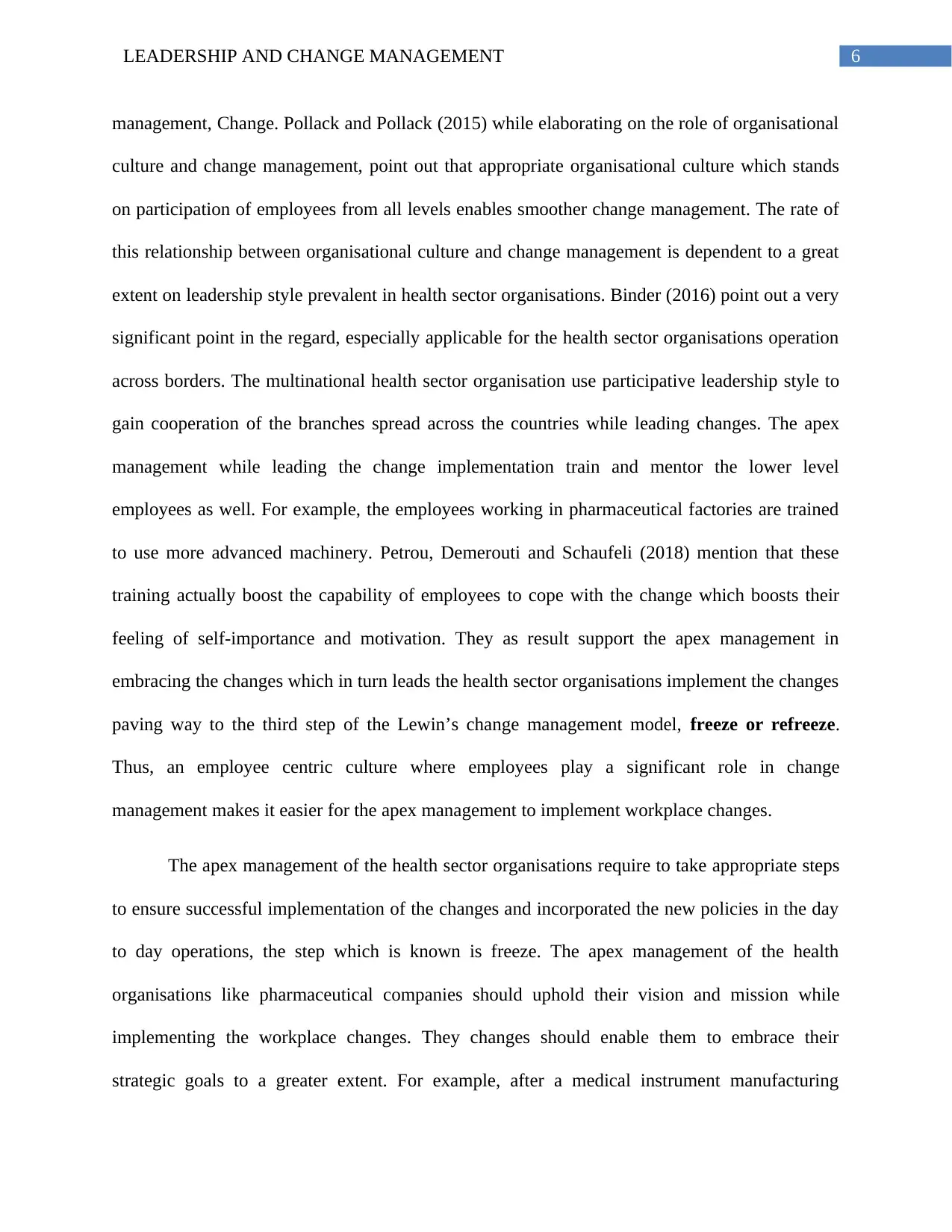
6LEADERSHIP AND CHANGE MANAGEMENT
management, Change. Pollack and Pollack (2015) while elaborating on the role of organisational
culture and change management, point out that appropriate organisational culture which stands
on participation of employees from all levels enables smoother change management. The rate of
this relationship between organisational culture and change management is dependent to a great
extent on leadership style prevalent in health sector organisations. Binder (2016) point out a very
significant point in the regard, especially applicable for the health sector organisations operation
across borders. The multinational health sector organisation use participative leadership style to
gain cooperation of the branches spread across the countries while leading changes. The apex
management while leading the change implementation train and mentor the lower level
employees as well. For example, the employees working in pharmaceutical factories are trained
to use more advanced machinery. Petrou, Demerouti and Schaufeli (2018) mention that these
training actually boost the capability of employees to cope with the change which boosts their
feeling of self-importance and motivation. They as result support the apex management in
embracing the changes which in turn leads the health sector organisations implement the changes
paving way to the third step of the Lewin’s change management model, freeze or refreeze.
Thus, an employee centric culture where employees play a significant role in change
management makes it easier for the apex management to implement workplace changes.
The apex management of the health sector organisations require to take appropriate steps
to ensure successful implementation of the changes and incorporated the new policies in the day
to day operations, the step which is known is freeze. The apex management of the health
organisations like pharmaceutical companies should uphold their vision and mission while
implementing the workplace changes. They changes should enable them to embrace their
strategic goals to a greater extent. For example, after a medical instrument manufacturing
management, Change. Pollack and Pollack (2015) while elaborating on the role of organisational
culture and change management, point out that appropriate organisational culture which stands
on participation of employees from all levels enables smoother change management. The rate of
this relationship between organisational culture and change management is dependent to a great
extent on leadership style prevalent in health sector organisations. Binder (2016) point out a very
significant point in the regard, especially applicable for the health sector organisations operation
across borders. The multinational health sector organisation use participative leadership style to
gain cooperation of the branches spread across the countries while leading changes. The apex
management while leading the change implementation train and mentor the lower level
employees as well. For example, the employees working in pharmaceutical factories are trained
to use more advanced machinery. Petrou, Demerouti and Schaufeli (2018) mention that these
training actually boost the capability of employees to cope with the change which boosts their
feeling of self-importance and motivation. They as result support the apex management in
embracing the changes which in turn leads the health sector organisations implement the changes
paving way to the third step of the Lewin’s change management model, freeze or refreeze.
Thus, an employee centric culture where employees play a significant role in change
management makes it easier for the apex management to implement workplace changes.
The apex management of the health sector organisations require to take appropriate steps
to ensure successful implementation of the changes and incorporated the new policies in the day
to day operations, the step which is known is freeze. The apex management of the health
organisations like pharmaceutical companies should uphold their vision and mission while
implementing the workplace changes. They changes should enable them to embrace their
strategic goals to a greater extent. For example, after a medical instrument manufacturing
Paraphrase This Document
Need a fresh take? Get an instant paraphrase of this document with our AI Paraphraser
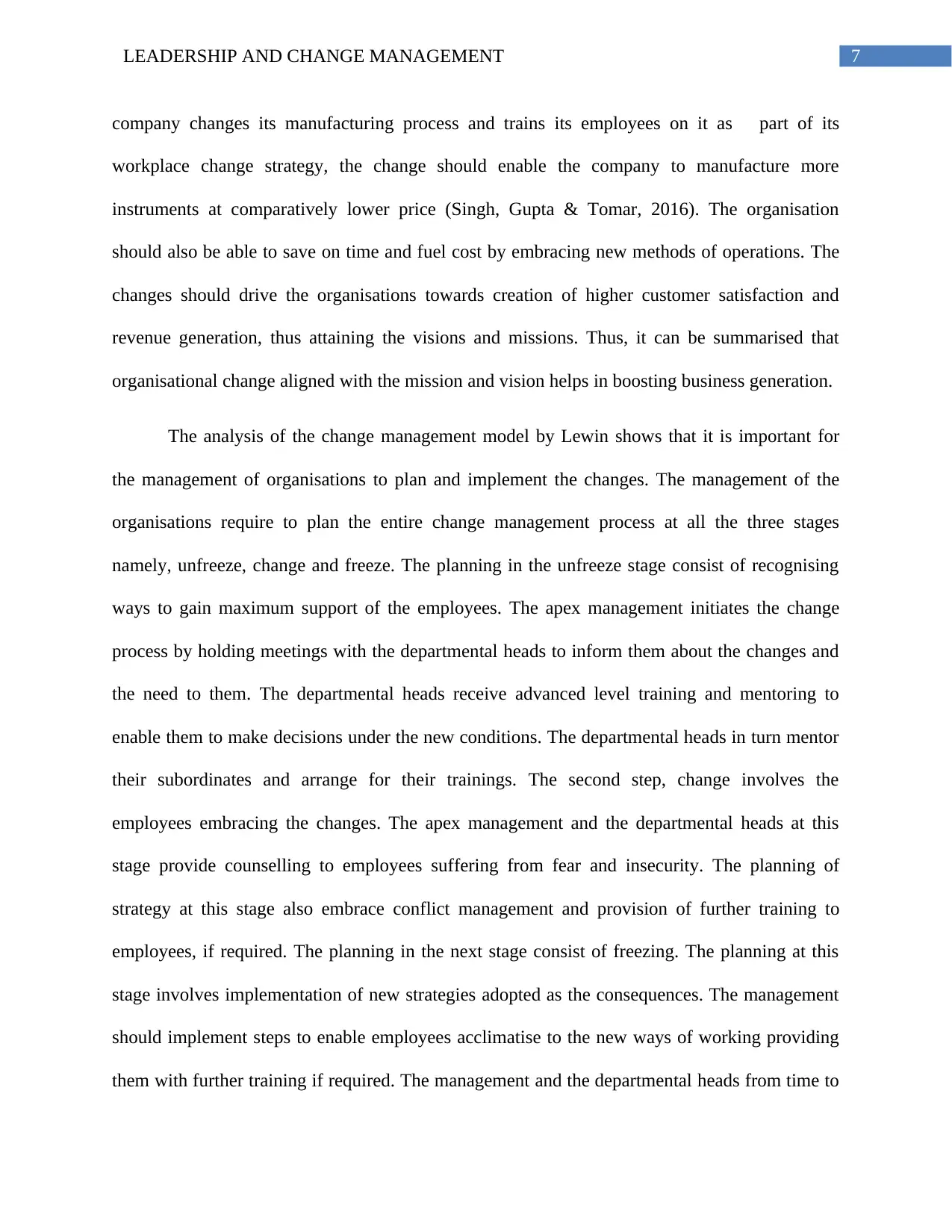
7LEADERSHIP AND CHANGE MANAGEMENT
company changes its manufacturing process and trains its employees on it as part of its
workplace change strategy, the change should enable the company to manufacture more
instruments at comparatively lower price (Singh, Gupta & Tomar, 2016). The organisation
should also be able to save on time and fuel cost by embracing new methods of operations. The
changes should drive the organisations towards creation of higher customer satisfaction and
revenue generation, thus attaining the visions and missions. Thus, it can be summarised that
organisational change aligned with the mission and vision helps in boosting business generation.
The analysis of the change management model by Lewin shows that it is important for
the management of organisations to plan and implement the changes. The management of the
organisations require to plan the entire change management process at all the three stages
namely, unfreeze, change and freeze. The planning in the unfreeze stage consist of recognising
ways to gain maximum support of the employees. The apex management initiates the change
process by holding meetings with the departmental heads to inform them about the changes and
the need to them. The departmental heads receive advanced level training and mentoring to
enable them to make decisions under the new conditions. The departmental heads in turn mentor
their subordinates and arrange for their trainings. The second step, change involves the
employees embracing the changes. The apex management and the departmental heads at this
stage provide counselling to employees suffering from fear and insecurity. The planning of
strategy at this stage also embrace conflict management and provision of further training to
employees, if required. The planning in the next stage consist of freezing. The planning at this
stage involves implementation of new strategies adopted as the consequences. The management
should implement steps to enable employees acclimatise to the new ways of working providing
them with further training if required. The management and the departmental heads from time to
company changes its manufacturing process and trains its employees on it as part of its
workplace change strategy, the change should enable the company to manufacture more
instruments at comparatively lower price (Singh, Gupta & Tomar, 2016). The organisation
should also be able to save on time and fuel cost by embracing new methods of operations. The
changes should drive the organisations towards creation of higher customer satisfaction and
revenue generation, thus attaining the visions and missions. Thus, it can be summarised that
organisational change aligned with the mission and vision helps in boosting business generation.
The analysis of the change management model by Lewin shows that it is important for
the management of organisations to plan and implement the changes. The management of the
organisations require to plan the entire change management process at all the three stages
namely, unfreeze, change and freeze. The planning in the unfreeze stage consist of recognising
ways to gain maximum support of the employees. The apex management initiates the change
process by holding meetings with the departmental heads to inform them about the changes and
the need to them. The departmental heads receive advanced level training and mentoring to
enable them to make decisions under the new conditions. The departmental heads in turn mentor
their subordinates and arrange for their trainings. The second step, change involves the
employees embracing the changes. The apex management and the departmental heads at this
stage provide counselling to employees suffering from fear and insecurity. The planning of
strategy at this stage also embrace conflict management and provision of further training to
employees, if required. The planning in the next stage consist of freezing. The planning at this
stage involves implementation of new strategies adopted as the consequences. The management
should implement steps to enable employees acclimatise to the new ways of working providing
them with further training if required. The management and the departmental heads from time to

8LEADERSHIP AND CHANGE MANAGEMENT
time must measure the outcome of the new processes adopted as the result of the changes. They
must take steps to rectify and change the strategies if required.
There are several factors both within and outside the health sector organisations which
act facilitators and barriers to change. The technological advancements taking place in the
pharmaceutical sector like use of ecommerce to acquire raw materials for medicines and
continuous the suppliers provide to the companies over the digital space encourage the business
organisations embrace changes like installation of new manufacturing plant. Again, market
opportunities like entering new markets act as strong drivers of changes within the entire
organisational structures of multinational health sector companies. Grant (2016) provides
evidence to this driver in his work, “Contemporary strategy analysis: Text and cases edition”.
He pointed out that multinational pharmaceutical and healthcare companies integrate their global
strategies which they frame for their global market and local strategies which they make for
individual markets. These companies form local strategies adapting the local market conditions
which means the apex management and regional managers have to exhibit a great deal of
flexibility as well during planning. Thus leadership during change is not limited to
implementation but embraces the ability to modify plans whenever required. The multinational
companies in order to meet this newly emerging business have already started flattening their
structures to make their decision making process more dynamic. Thus, it can be inferred that
leadership in change management also embraces making decision making more dynamic.
However, the factors which drive changes in one company may turn out to be barriers (Petrou,
Demerouti & Schaufeli, 2018).
Financial resources prove to be one of the greatest barriers to implementation of changes
in the health sector firms. The organisational changes like changing to flat decision making
time must measure the outcome of the new processes adopted as the result of the changes. They
must take steps to rectify and change the strategies if required.
There are several factors both within and outside the health sector organisations which
act facilitators and barriers to change. The technological advancements taking place in the
pharmaceutical sector like use of ecommerce to acquire raw materials for medicines and
continuous the suppliers provide to the companies over the digital space encourage the business
organisations embrace changes like installation of new manufacturing plant. Again, market
opportunities like entering new markets act as strong drivers of changes within the entire
organisational structures of multinational health sector companies. Grant (2016) provides
evidence to this driver in his work, “Contemporary strategy analysis: Text and cases edition”.
He pointed out that multinational pharmaceutical and healthcare companies integrate their global
strategies which they frame for their global market and local strategies which they make for
individual markets. These companies form local strategies adapting the local market conditions
which means the apex management and regional managers have to exhibit a great deal of
flexibility as well during planning. Thus leadership during change is not limited to
implementation but embraces the ability to modify plans whenever required. The multinational
companies in order to meet this newly emerging business have already started flattening their
structures to make their decision making process more dynamic. Thus, it can be inferred that
leadership in change management also embraces making decision making more dynamic.
However, the factors which drive changes in one company may turn out to be barriers (Petrou,
Demerouti & Schaufeli, 2018).
Financial resources prove to be one of the greatest barriers to implementation of changes
in the health sector firms. The organisational changes like changing to flat decision making
⊘ This is a preview!⊘
Do you want full access?
Subscribe today to unlock all pages.

Trusted by 1+ million students worldwide
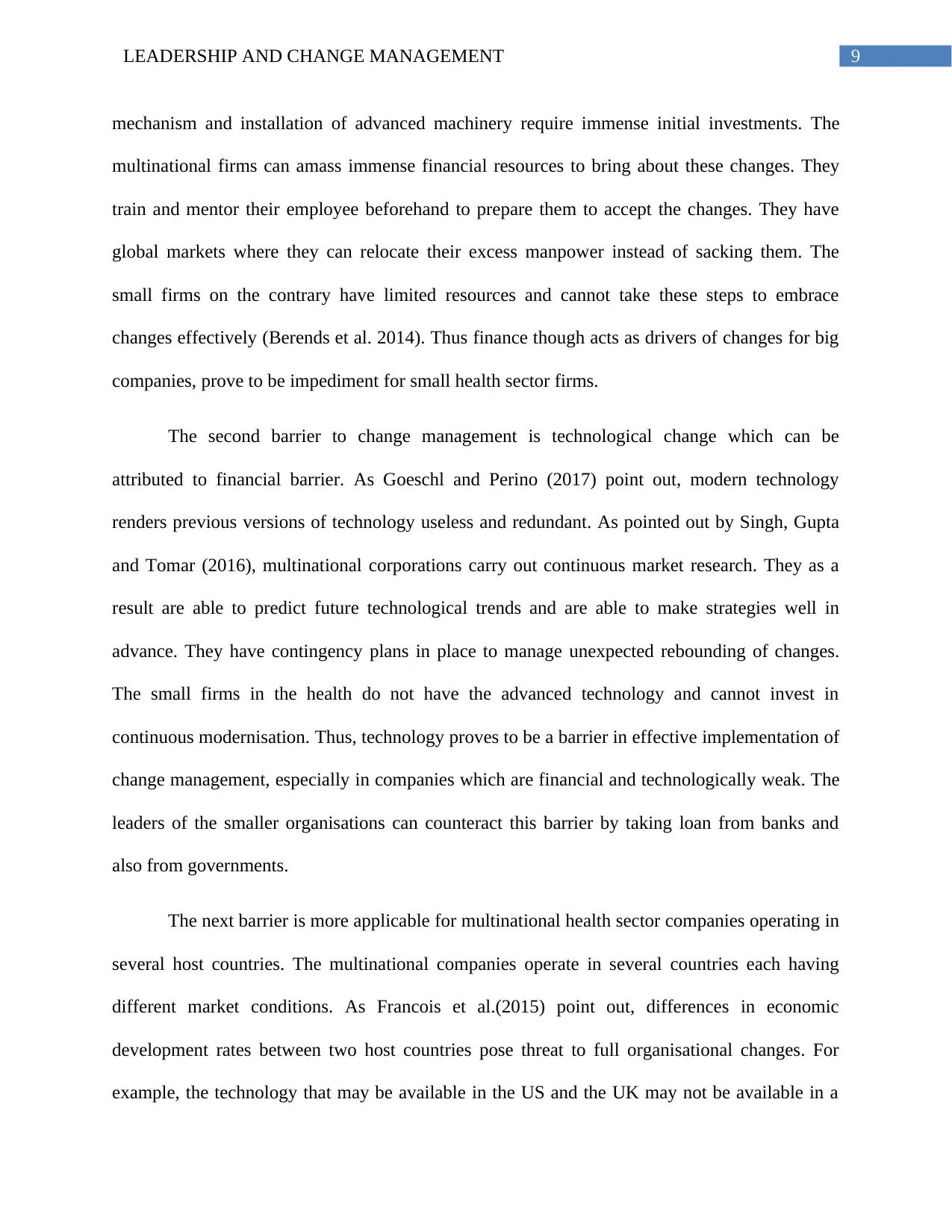
9LEADERSHIP AND CHANGE MANAGEMENT
mechanism and installation of advanced machinery require immense initial investments. The
multinational firms can amass immense financial resources to bring about these changes. They
train and mentor their employee beforehand to prepare them to accept the changes. They have
global markets where they can relocate their excess manpower instead of sacking them. The
small firms on the contrary have limited resources and cannot take these steps to embrace
changes effectively (Berends et al. 2014). Thus finance though acts as drivers of changes for big
companies, prove to be impediment for small health sector firms.
The second barrier to change management is technological change which can be
attributed to financial barrier. As Goeschl and Perino (2017) point out, modern technology
renders previous versions of technology useless and redundant. As pointed out by Singh, Gupta
and Tomar (2016), multinational corporations carry out continuous market research. They as a
result are able to predict future technological trends and are able to make strategies well in
advance. They have contingency plans in place to manage unexpected rebounding of changes.
The small firms in the health do not have the advanced technology and cannot invest in
continuous modernisation. Thus, technology proves to be a barrier in effective implementation of
change management, especially in companies which are financial and technologically weak. The
leaders of the smaller organisations can counteract this barrier by taking loan from banks and
also from governments.
The next barrier is more applicable for multinational health sector companies operating in
several host countries. The multinational companies operate in several countries each having
different market conditions. As Francois et al.(2015) point out, differences in economic
development rates between two host countries pose threat to full organisational changes. For
example, the technology that may be available in the US and the UK may not be available in a
mechanism and installation of advanced machinery require immense initial investments. The
multinational firms can amass immense financial resources to bring about these changes. They
train and mentor their employee beforehand to prepare them to accept the changes. They have
global markets where they can relocate their excess manpower instead of sacking them. The
small firms on the contrary have limited resources and cannot take these steps to embrace
changes effectively (Berends et al. 2014). Thus finance though acts as drivers of changes for big
companies, prove to be impediment for small health sector firms.
The second barrier to change management is technological change which can be
attributed to financial barrier. As Goeschl and Perino (2017) point out, modern technology
renders previous versions of technology useless and redundant. As pointed out by Singh, Gupta
and Tomar (2016), multinational corporations carry out continuous market research. They as a
result are able to predict future technological trends and are able to make strategies well in
advance. They have contingency plans in place to manage unexpected rebounding of changes.
The small firms in the health do not have the advanced technology and cannot invest in
continuous modernisation. Thus, technology proves to be a barrier in effective implementation of
change management, especially in companies which are financial and technologically weak. The
leaders of the smaller organisations can counteract this barrier by taking loan from banks and
also from governments.
The next barrier is more applicable for multinational health sector companies operating in
several host countries. The multinational companies operate in several countries each having
different market conditions. As Francois et al.(2015) point out, differences in economic
development rates between two host countries pose threat to full organisational changes. For
example, the technology that may be available in the US and the UK may not be available in a
Paraphrase This Document
Need a fresh take? Get an instant paraphrase of this document with our AI Paraphraser
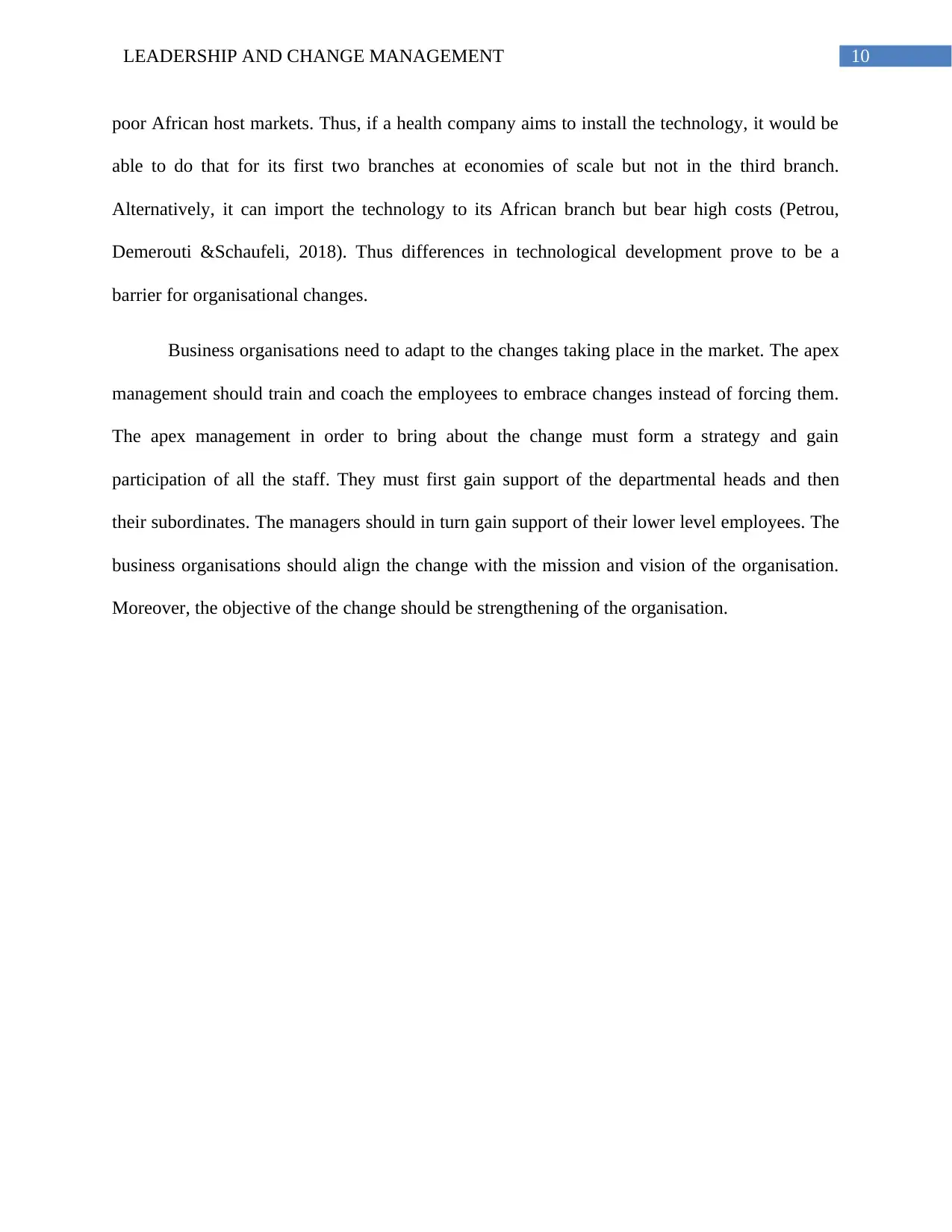
10LEADERSHIP AND CHANGE MANAGEMENT
poor African host markets. Thus, if a health company aims to install the technology, it would be
able to do that for its first two branches at economies of scale but not in the third branch.
Alternatively, it can import the technology to its African branch but bear high costs (Petrou,
Demerouti &Schaufeli, 2018). Thus differences in technological development prove to be a
barrier for organisational changes.
Business organisations need to adapt to the changes taking place in the market. The apex
management should train and coach the employees to embrace changes instead of forcing them.
The apex management in order to bring about the change must form a strategy and gain
participation of all the staff. They must first gain support of the departmental heads and then
their subordinates. The managers should in turn gain support of their lower level employees. The
business organisations should align the change with the mission and vision of the organisation.
Moreover, the objective of the change should be strengthening of the organisation.
poor African host markets. Thus, if a health company aims to install the technology, it would be
able to do that for its first two branches at economies of scale but not in the third branch.
Alternatively, it can import the technology to its African branch but bear high costs (Petrou,
Demerouti &Schaufeli, 2018). Thus differences in technological development prove to be a
barrier for organisational changes.
Business organisations need to adapt to the changes taking place in the market. The apex
management should train and coach the employees to embrace changes instead of forcing them.
The apex management in order to bring about the change must form a strategy and gain
participation of all the staff. They must first gain support of the departmental heads and then
their subordinates. The managers should in turn gain support of their lower level employees. The
business organisations should align the change with the mission and vision of the organisation.
Moreover, the objective of the change should be strengthening of the organisation.
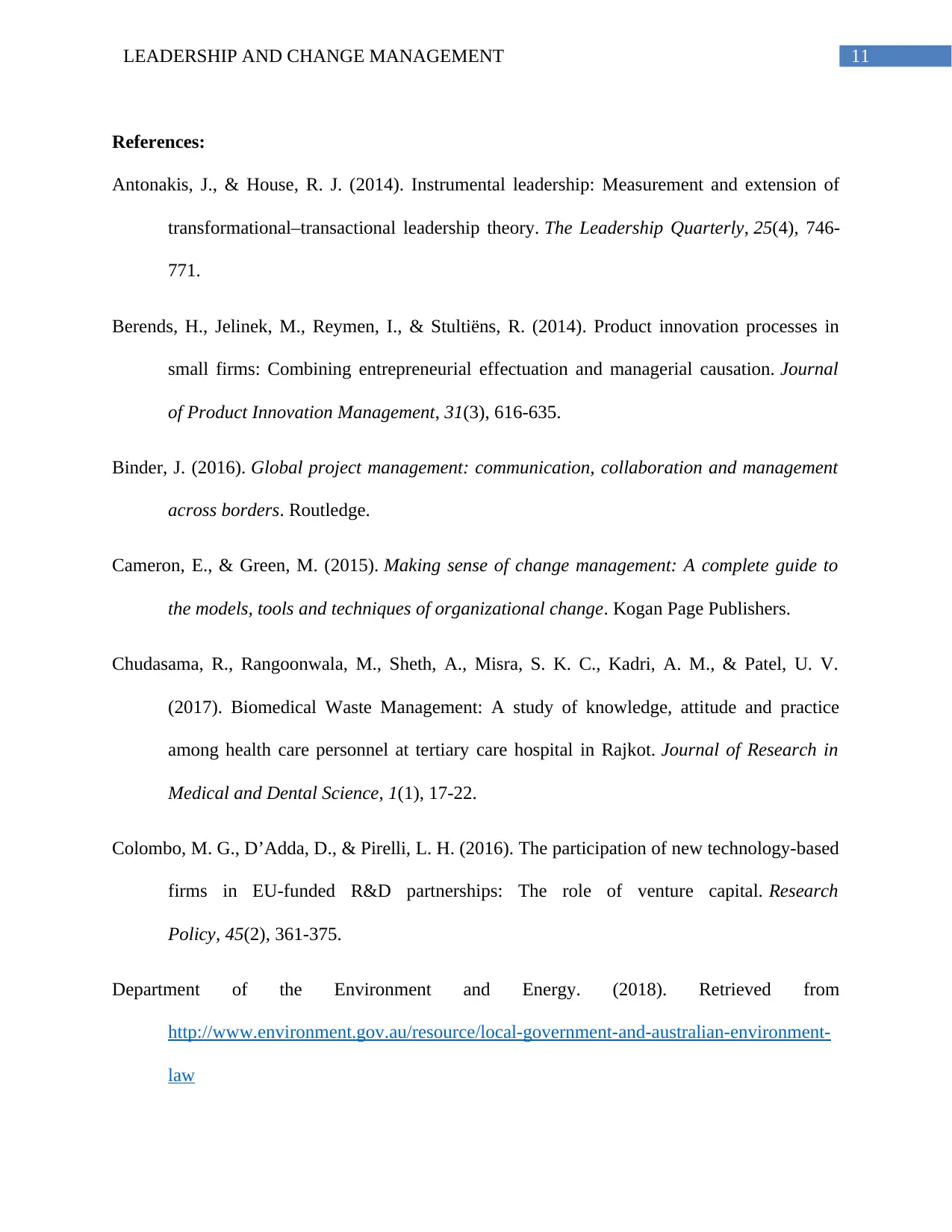
11LEADERSHIP AND CHANGE MANAGEMENT
References:
Antonakis, J., & House, R. J. (2014). Instrumental leadership: Measurement and extension of
transformational–transactional leadership theory. The Leadership Quarterly, 25(4), 746-
771.
Berends, H., Jelinek, M., Reymen, I., & Stultiëns, R. (2014). Product innovation processes in
small firms: Combining entrepreneurial effectuation and managerial causation. Journal
of Product Innovation Management, 31(3), 616-635.
Binder, J. (2016). Global project management: communication, collaboration and management
across borders. Routledge.
Cameron, E., & Green, M. (2015). Making sense of change management: A complete guide to
the models, tools and techniques of organizational change. Kogan Page Publishers.
Chudasama, R., Rangoonwala, M., Sheth, A., Misra, S. K. C., Kadri, A. M., & Patel, U. V.
(2017). Biomedical Waste Management: A study of knowledge, attitude and practice
among health care personnel at tertiary care hospital in Rajkot. Journal of Research in
Medical and Dental Science, 1(1), 17-22.
Colombo, M. G., D’Adda, D., & Pirelli, L. H. (2016). The participation of new technology-based
firms in EU-funded R&D partnerships: The role of venture capital. Research
Policy, 45(2), 361-375.
Department of the Environment and Energy. (2018). Retrieved from
http://www.environment.gov.au/resource/local-government-and-australian-environment-
law
References:
Antonakis, J., & House, R. J. (2014). Instrumental leadership: Measurement and extension of
transformational–transactional leadership theory. The Leadership Quarterly, 25(4), 746-
771.
Berends, H., Jelinek, M., Reymen, I., & Stultiëns, R. (2014). Product innovation processes in
small firms: Combining entrepreneurial effectuation and managerial causation. Journal
of Product Innovation Management, 31(3), 616-635.
Binder, J. (2016). Global project management: communication, collaboration and management
across borders. Routledge.
Cameron, E., & Green, M. (2015). Making sense of change management: A complete guide to
the models, tools and techniques of organizational change. Kogan Page Publishers.
Chudasama, R., Rangoonwala, M., Sheth, A., Misra, S. K. C., Kadri, A. M., & Patel, U. V.
(2017). Biomedical Waste Management: A study of knowledge, attitude and practice
among health care personnel at tertiary care hospital in Rajkot. Journal of Research in
Medical and Dental Science, 1(1), 17-22.
Colombo, M. G., D’Adda, D., & Pirelli, L. H. (2016). The participation of new technology-based
firms in EU-funded R&D partnerships: The role of venture capital. Research
Policy, 45(2), 361-375.
Department of the Environment and Energy. (2018). Retrieved from
http://www.environment.gov.au/resource/local-government-and-australian-environment-
law
⊘ This is a preview!⊘
Do you want full access?
Subscribe today to unlock all pages.

Trusted by 1+ million students worldwide
1 out of 14
Related Documents
Your All-in-One AI-Powered Toolkit for Academic Success.
+13062052269
info@desklib.com
Available 24*7 on WhatsApp / Email
![[object Object]](/_next/static/media/star-bottom.7253800d.svg)
Unlock your academic potential
Copyright © 2020–2025 A2Z Services. All Rights Reserved. Developed and managed by ZUCOL.





